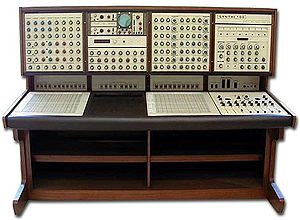EMS Synthi 100

The EMS Synthi 100 was a large analogue synthesizer made by Electronic Music Studios (London) Ltd. It was released in 1974 and cost $25,000. Around 30 units (29, according to some sources) were built during the 1970s and 1980s.
The Synthi 100 was developed from a combination of three VCS-3 Systems, ending up with 12 VCOs, two keyboards (each of it duophonic, making it possible to play 4 voices simultaneously), and a 3-track 256-step monophonic digital sequencer. Two 64 x 64 patchbays were used to connect the different modules. The keyboard spread could/had to be adjusted, making it difficult to play a tuned temperated scale for a longer time, but allow for alternative tunings easily.
The sound of the Synthi-100 was subtly distinct from the VCS-3. Both filters and oscillators were much more stable in the Synthi-100. The instrument, however, was very sensitive to temperature changes, so it required repeated re-tuning.
The Synthi 100 also had an add-on computer interface known as "Computer Synthi" which contained a PDP-8 Minicomputer and 4Kb of Random Access Memory. It featured an LED display, twin digital cassettes, Two 24 x 60 matrix patchboards, and a switch button control panel. Three were built.
Also the Vocoder 5000 (Studio Vocoder) was available as a separate module installed into the Synthi 100. It contained a 22 band filter, 22 x 22 matrix patchboard, Mic/Line Inputs, 2 Oscillators and Noise sources, Frequency Shifter, Pitch to Voltage Extractor, and a Spectrum display driver.
Users
One Synthi 100 (named the 'Delaware') was sold to the BBC Radiophonic Workshop. It was used to generate music sound effects for the BBC's radio and television shows, including Doctor Who and Blake's Seven for television, and the Hitchhiker's Guide To The Galaxy radio series.[citation needed]
The Synthi 100 owned by Jack Dangers can be heard being used extensively on electronica group Meat Beat Manifesto's album R.U.O.K.?.[1] Many photos from that album's CD sleeve are close-up photos of the Synthi 100's control panels and displays. It was claimed that his unit is the only one still in working condition, however, the university of Osnabrück, Germany, owns one (Synthi 200) and uses it in their department and there is a working Synthi100 at the Cantos Music Foundation in Alberta, Canada.[2][failed verification]
Bruno Spoerri's Synthi-100 was offered for sale in May 1979 for SFr. 48,000 with "new filters, additional envelope shapers, inverters, additional inputs, etc..."[citation needed]
The Synthi 100 was used by Elizabeth Parker with the BBC Radiophonic Workshop, and by Karlheinz Stockhausen in Sirius.[citation needed]
Synthi 100 was also used by Soviet/Russian artist Eduard Artemyev when recording the film score for the Tarkovsky film Stalker (1979), his Metamorphoses album in 1980 (released: «Мелодия», С10-13889-90, СССР), his Moods album in 1984 («Мелодия», C10-21077-002) and later with numerous TV and movie soundtracks.[citation needed]
Billy Corgan, longtime frontman of The Smashing Pumpkins, is also reported to own one.[3]
External links
- Synth Museum article
- Inventory of the University of Osnabrück with a Synthi 100 labelled "Synthi 200"
- Article on the restored 'Digitana' model at sonicstate.com
- Specifications booklet (9.20 MB PDF)
- The EMS SYNTHI BLOG
References
- ^ "Jack Dangers: Master of Dub Electronica". Retrieved 2009-09-14.
- ^ http://cantos.ca/explore/collection-checklist
- ^ "synthfool". Retrieved 2009-09-14.
